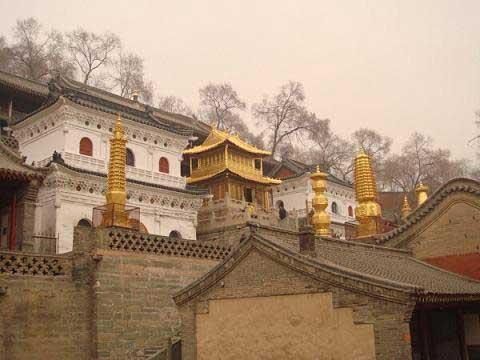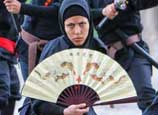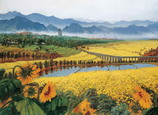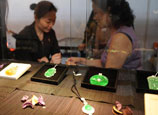
 |
| Mount Wutai (CNTV) |
Therefore, the two monks received the right to build the temple. There were various peaks, grounds and rivers in the mountains, so where was the perfect place for building the temple? The "Records of Qingliang Mountain" show that "on the left side of the great tower, there were footprints of the Sakyamuni Buddha, which were 1.6 chi long and 0.6 chi wide and had complete and clear toe prints and lines." It is said that the two monks not only found the footprints but also found the Buddha's relics. The peak in the Yingfang Village was majestic and unusual, and looked quite like Mount Gridhakutta (Sakyamuni Buddha's practicing place) in India. For these reasons, they decided to build the temple on this peak. The completed temple was named the Lingjiu Temple. Emperor Hanming added "Dafu" (meaning faith) before it, and then the full name of the temple became the Dafu Lingjiu Temple. It was the former body of the current Xiantong Temple. From then on, Mount Wutai became the center of China's Buddhism. The Dafu Lingjiu Temple and the White Horse Temple were the earliest Buddhist temples of China.
Prosperous periods in history
During the Northern and Southern Dynasties, Mount Wutai's Buddhism stepped into its first prosperous period. The Emperor Xiaowen of the Northern Wei Dynasty greatly extended the Lingjiu Temple and also built another 12 temples around it, including the Shanjing Temple and Zhenrong Temple. In the Northern Qi Dynasty, the number of Mount Wutai's temples increased to over 200. In the Sui Dynasty, the Emperor Wen built five temples on the five peaks, which were the Wanghai Temple on the Eastern Peak, Puji Temple on the Southern Peak, Falei Temple on the Western Peak, Lingying Temple on the Northern Peak and Yanjiao Temple on the Central Peak. Since Mount Wutai was the place where the Bodhisattva Manjusri gave lectures, the Bodhisattva Manjusri was worshipped in all five temples on the five peaks. However, he had five different titles. In the Wanghai Temple it was the Wise Manjusri, in the Puji Temple it was the Intelligent Manjusri, in the Falei Temple it was the Lion Manjusri, in the Lingying Temple it was the Spotless Manjusri, and in the Central Temple it was the Childish Manjusri. From then on, all the people who journeyed to Mount Wutai to worship would go to the five temples to pay their respects. At that time, the name Mount Wutai had frequently appeared in historical books of the Northern Qi Dynasty.
【11】 【12】 【13】 【14】 【15】 【16】 【17】 【18】 【19】 【20】
【21】


















 Rainstorms flood more than 10,000 cars in underground garages in Wuhan
Rainstorms flood more than 10,000 cars in underground garages in Wuhan


![]()
